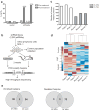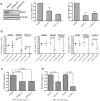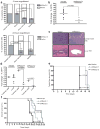In vivo RNAi screening identifies regulators of actin dynamics as key determinants of lymphoma progression
- PMID: 19783987
- PMCID: PMC2756700
- DOI: 10.1038/ng.451
In vivo RNAi screening identifies regulators of actin dynamics as key determinants of lymphoma progression
Abstract
Mouse models have markedly improved our understanding of cancer development and tumor biology. However, these models have shown limited efficacy as tractable systems for unbiased genetic experimentation. Here, we report the adaptation of loss-of-function screening to mouse models of cancer. Specifically, we have been able to introduce a library of shRNAs into individual mice using transplantable Emu-myc lymphoma cells. This approach has allowed us to screen nearly 1,000 genetic alterations in the context of a single tumor-bearing mouse. These experiments have identified a central role for regulators of actin dynamics and cell motility in lymphoma cell homeostasis in vivo. Validation experiments confirmed that these proteins represent bona fide lymphoma drug targets. Additionally, suppression of two of these targets, Rac2 and twinfilin, potentiated the action of the front-line chemotherapeutic vincristine, suggesting a critical relationship between cell motility and tumor relapse in hematopoietic malignancies.
Figures




Similar articles
-
Rac-WAVE2 signaling is involved in the invasive and metastatic phenotypes of murine melanoma cells.Oncogene. 2005 Feb 17;24(8):1309-19. doi: 10.1038/sj.onc.1208177. Oncogene. 2005. PMID: 15608687
-
FilGAP, a Rho- and ROCK-regulated GAP for Rac binds filamin A to control actin remodelling.Nat Cell Biol. 2006 Aug;8(8):803-14. doi: 10.1038/ncb1437. Epub 2006 Jul 23. Nat Cell Biol. 2006. PMID: 16862148
-
WAVE2 deficiency reveals distinct roles in embryogenesis and Rac-mediated actin-based motility.EMBO J. 2003 Jul 15;22(14):3602-12. doi: 10.1093/emboj/cdg350. EMBO J. 2003. PMID: 12853475 Free PMC article.
-
Small-molecule inhibitors of actin dynamics and cell motility.Curr Top Med Chem. 2003;3(6):593-616. doi: 10.2174/1568026033452348. Curr Top Med Chem. 2003. PMID: 12570855 Review.
-
Regulation of actin dynamics by WASP family proteins.J Biochem. 2003 Sep;134(3):309-13. doi: 10.1093/jb/mvg146. J Biochem. 2003. PMID: 14561714 Review.
Cited by
-
MicroRNA-486-5p improves nonsmall-cell lung cancer chemotherapy sensitivity and inhibits epithelial-mesenchymal transition by targeting twinfilin actin binding protein 1.J Int Med Res. 2019 Aug;47(8):3745-3756. doi: 10.1177/0300060519850739. Epub 2019 May 23. J Int Med Res. 2019. PMID: 31117868 Free PMC article.
-
RNAi screening: new approaches, understandings, and organisms.Wiley Interdiscip Rev RNA. 2012 Mar-Apr;3(2):145-58. doi: 10.1002/wrna.110. Epub 2011 Sep 22. Wiley Interdiscip Rev RNA. 2012. PMID: 21953743 Free PMC article. Review.
-
An in vivo functional genomics screen of nuclear receptors and their co-regulators identifies FOXA1 as an essential gene in lung tumorigenesis.Neoplasia. 2020 Aug;22(8):294-310. doi: 10.1016/j.neo.2020.04.005. Epub 2020 May 13. Neoplasia. 2020. PMID: 32512502 Free PMC article.
-
Glutaminolysis regulates endometrial fibrosis in intrauterine adhesion via modulating mitochondrial function.Biol Res. 2024 Apr 1;57(1):13. doi: 10.1186/s40659-024-00492-3. Biol Res. 2024. PMID: 38561846 Free PMC article.
-
Life in the fast lane: mammalian disease models in the genomics era.Cell. 2012 Mar 16;148(6):1099-109. doi: 10.1016/j.cell.2012.02.023. Cell. 2012. PMID: 22424222 Free PMC article.
References
-
- van Lohuizen M, et al. Identification of cooperating oncogenes in E mu-myc transgenic mice by provirus tagging. Cell. 1991;65:737–52. - PubMed
-
- Jonkers J, Berns A. Retroviral insertional mutagenesis as a strategy to identify cancer genes. Biochim Biophys Acta. 1996;1287:29–57. - PubMed
-
- Dupuy AJ, Akagi K, Largaespada DA, Copeland NG, Jenkins NA. Mammalian mutagenesis using a highly mobile somatic Sleeping Beauty transposon system. Nature. 2005;436:221–6. - PubMed
-
- Collier LS, Carlson CM, Ravimohan S, Dupuy AJ, Largaespada DA. Cancer gene discovery in solid tumours using transposon-based somatic mutagenesis in the mouse. Nature. 2005;436:272–6. - PubMed
Publication types
MeSH terms
Substances
Associated data
- Actions
Grants and funding
LinkOut - more resources
Full Text Sources
Medical
Molecular Biology Databases

